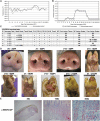High dose of vesicular stomatitis virus-vectored Ebola virus vaccine causes vesicular disease in swine without horizontal transmission
- PMID: 33719915
- PMCID: PMC8023602
- DOI: 10.1080/22221751.2021.1903343
High dose of vesicular stomatitis virus-vectored Ebola virus vaccine causes vesicular disease in swine without horizontal transmission
Abstract
ABSTRACTThe recent impact of Ebola virus disease (EVD) on public health in Africa clearly demonstrates the need for a safe and efficacious vaccine to control outbreaks and mitigate its threat to global health. ERVEBO® is an effective recombinant Vesicular Stomatitis Virus (VSV)-vectored Ebola virus vaccine (VSV-EBOV) that was approved by the FDA and EMA in late 2019 for use in prevention of EVD. Since the parental virus VSV, which was used to construct VSV-EBOV, is pathogenic for livestock and the vaccine virus may be shed at low levels by vaccinated humans, widespread deployment of the vaccine requires investigation into its infectivity and transmissibility in VSV-susceptible livestock species. We therefore performed a comprehensive clinical analysis of the VSV-EBOV vaccine virus in swine to determine its infectivity and potential for transmission. A high dose of VSV-EBOV resulted in VSV-like clinical signs in swine, with a proportion of pigs developing ulcerative vesicular lesions at the nasal injection site and feet. Uninoculated contact control pigs co-mingled with VSV-EBOV-inoculated pigs did not become infected or display any clinical signs of disease, indicating the vaccine is not readily transmissible to naïve pigs during prolonged close contact. In contrast, virulent wild-type VSV Indiana had a shorter incubation period and was transmitted to contact control pigs. These results indicate that the VSV-EBOV vaccine causes vesicular illness in swine when administered at a high dose. Moreover, the study demonstrates the VSV-EBOV vaccine is not readily transmitted to uninfected pigs, encouraging its safe use as an effective human vaccine.
Keywords: Ebola virus disease; VSV; safety study; swine; virus-vectored vaccine.
Conflict of interest statement
Sheri Dubey, Sean P. Troth, and Beth-Ann Coller are employees of Merck & Co., Inc., Kenilworth, NJ USA and may have shares in the company and/or patents relating to the technology. Richard Nichols reports personal fees from NewLink Genetics and Crozet BioPharma. Thomas P. Monath reports personal fees from NewLink Genetics Corp. and Merck Inc. Thomas P. Monath, Richard Nichols, and Brian K. Martin were associated with Bioprotection Systems, Inc., during the course of the study. Bioprotection Systems, Inc., licensed the VSV-EBOV vaccine from Public Health Canada and sub-licensed the vaccine to Merck & Co., Inc.
Figures




References
-
- Rojas M, Monsalve DM, Pacheco Y, et al. Ebola virus disease: An emerging and re-emerging viral threat. J Autoimmun. 2020 Jan;106:102375. - PubMed
-
- Bausch DG. West Africa 2013 Ebola: from virus outbreak to humanitarian crisis. Curr Top Microbiol Immunol. 2017;411:63–92. - PubMed
-
- Higgs ES, Dubey SA, Coller BAG, et al. Accelerating vaccine development during the 2013–2016 West African Ebola virus disease outbreak. Curr Top Microbiol Immunol. 2017;411:229–261. - PubMed
MeSH terms
Substances
Grants and funding
LinkOut - more resources
Full Text Sources
Other Literature Sources
Medical
Research Materials
